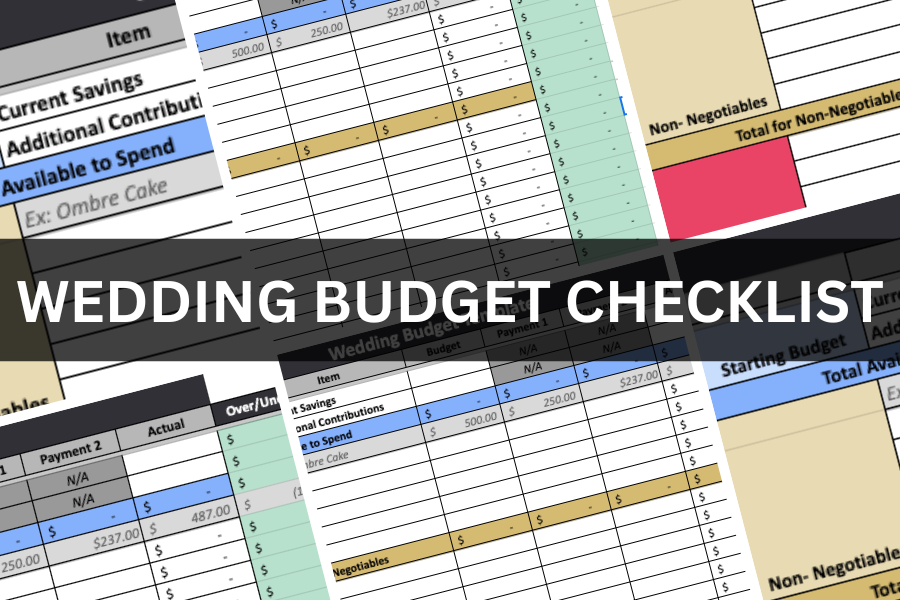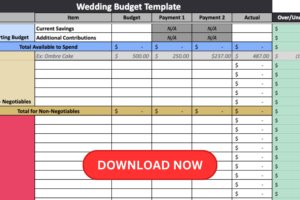When I was first starting to plan my wedding, I had no idea where to start. I struggled to know what to expect and what my options were for cutting down costs. So I’ve put together this wedding budget checklist and wedding budget template to help you build a budget you can actually stick to!
Ok I get it, budgeting is the least fun aspect of planning a wedding. But unless you’re Richie Rich, it’s a necessary evil. The good news is I can help! I’ve been through this already and considering how terrible I am with anything financial-related, if I can get through this, so can you!
This budget template is what I use for my daily expenses (yawn), and it really helped me not only save for my wedding, but really stick to our total budget. And as stressful as wedding planning can be, it’s much less stressful when you know where each dollar is going.
Ok enough chit-chat, let’s get into the nitty gritty. Here’s my tried-and-true wedding budget checklist and wedding budget spreadsheet that will make your life easier!
Creating a Budget
So where do we even begin? Most wedding budget breakdowns you’ve probably seen breakdown costs in the form of wedding budget percentages. So if you want to spend, say, $10,000 on your wedding, you would allow a certain percentage for each “item” on your checklist.
For example, if your total budget is $10,000 and the wedding venue is given 40% of your budget, you would allot $4,000 to spend on your venue. If cake was given 5%, you would spend $500 on the cake. Et cetera.
The problem I found with these percentages is not only can they become arbitrary, but they also don’t allow for the non-negotiables. The non-negotiables are the must-haves. The things you know you 100% cannot (or will not) cut.
CLICK HERE TO DOWNLOAD THE WEDDING BUDGET CHECKLIST FREE PDF
Start with the Non-Negotiables
Now don’t get me wrong, planning a wedding on a budget is a journey and there will be sacrifices. You’re probably going to be making more than one hard decision along the way, but I’ve found a way to make this process easier (and to make yourself feel like you’re not sacrificing everything) is to start with your non-negotiables.
Go ahead and make a list of everything you absolutely cannot sacrifice. This should obviously not be every single thing in your dream wedding, so consider these items carefully.
For example: when my husband and I were getting married, his non-negotiable was having a live mariachi band. Our second non-negotiable was the venue (a bowling alley).
Once you have your list of non-negotiables (again, it should be a short list), enter these into the budget template in the non-negotiable section.
The Necessary Costs
Next you’re going to want to list out all the necessary costs. This is where the wedding budget checklist comes into play. If you’re like me, there’s probably some expense you’re forgetting about.
You absolutely do not have to have all of the items on the checklist included in your wedding, so this section is flexible. There might even be some items listed individually that may be included as part of a package with your venue. If that’s the case, great! There also may be a “necessary cost” that for you is actually not even necessary (for example, the venue may not be an applicable expense if you’re having a backyard or city hall wedding).
The checklist is meant to serve as a brain dump for every possible expense that tend to come with weddings. Customize as necessary.
The Nice-to-Haves
These are the items that aren’t necessarily non-negotiables, but would ideally be included in your wedding. Allow me to use ice cream as a metaphor to illustrate what I mean:
Let’s say a wedding is a scoop of vanilla ice cream. The non-negotiables make that vanilla scoop your favorite flavor of ice cream (if vanilla is your favorite flavor, then just imagine your fave brand of vanilla ice cream). The nice-to-haves are your fave topping on top of your fave flavor. Does that make sense? Like, if you can’t afford the nice-to-haves, at least you still got your favorite ice cream.
Include a Miscellaneous Cushion
Trust me when I say there will be so much random stuff you didn’t account for that comes up leading up to (and on) your big day. Just so you’re not caught dead in the water, leave yourself a buffer in your budget.
I like to include this as a single line item in the budget, but you could have multiple line items if you want to break it down into categories like “random food”, “cab rides”, etc. Whatever is helpful for your brain, add it in.
Back into the Budget
So how do you figure out how much you need?? You’re going to “back into your budget”.
Take the list of non-negotiables and price those items out. Whether it’s a specific dress, venue, photographer, etc. price out what those items will cost you. These are the things you didn’t want to sacrifice, right? So this is where we need to start.
Once you have the associated cost of each of your non-negotiables, you’re going to go down the list of all the other items on your checklist and price each of these items out the same way.
At this stage, I’m sure you don’t have specific vendors or anything in mind, so you can just google a blanket number for the time being. For example, if you have no idea what kind of flowers you want, just do a quick google for “average cost of flowers” and put that number in. All of these numbers will be tailored later, but you need to have real numbers for every line item so you have a starting place.
Once you have a number filled in for every item that needs to be included in your budget, you’re probably having heart palpitations. I KNOW. The sticker shock is real, let me tell you. But you’re already ahead of the game by putting it all down on paper and trust me when I say, you’re setting yourself up for success.
Don’t get overwhelmed! It’s all going to turn out great.
Where to Cut Cost
If you’re like me, once you’ve done all the due diligence of entering a dollar amount for every line in your budget, you have number that is totally unrealistic. That’s ok! Go back to your non-negotiables and the necessary items. These are the two sections that should be considered the ‘bare minimum’ for your wedding.
Those necessary items definitely have some flexibility in them. Here are some ways to think about keeping cost down when planning a wedding on a budget:
- Find a venue that includes a food/alcohol package
- Or any other kind of package (music, etc). The fewer vendors you have to use, the better
- Consider no formal dinner
- We opted for hi-top tables and a buffet style dinner that stayed out for most of the event. This allowed guests to float around, mingle, and snack through the night.
- DIY what you can
- Ask your talented friends to offer you their services as your wedding gift
- Get creative with your choice of wedding venue
- For my wedding, we couldn’t afford our venue of choice in our city so we expanded our search and found the perfect spot a 2-hour drive from home.
- Don’t feel obligated to buy new
- I know it’s not everyone’s cup of tea, but lean on places like Craigslist, Facebook Marketplace and Reddit to find other brides who are looking to unload some of the stuff they bought for their wedding. Also: I bought my dress on eBay! I found the dress I wanted and then searched the designer name and style online. I spent $250 instead of $3,000.
- Consider an alternative wedding dessert to cake
- Limit the head count
- At my wedding, we had a hard 21+ rule and only invited folks that knew both of us
- Opt for an off-peak day of the week/ time of year
- This might be different for different venues, so don’t be afraid to ask! Ex: a Sunday night may be significantly less expensive than a Saturday night
(RELATED POST: 7 Alternative Wedding Centerpieces That Will Help You Stay on Budget)
How to Use the Template
- Using the Checklist as a guide, type items into each of the following sections under the “item” column:
- Non-Negotiables
- Nice-to-Haves
- Necessary Items
- Miscellaneous (add specifics to the Miscellaneous chart on the side to populate this line)
- Fill in dollar values for each item in the “Budget” column.
- Decide what is a realistic dollar value for your budget. Base this on the following factors:
- Your current savings
- What you can save in the time before the wedding
- Any contributions from family
- Once you have that realistic dollar value for how much you will spend on your wedding, enter that in the “starting budget” section at the top of the doc.
- Keep an eye on the “Final” total at the bottom. This will adjust based on your starting budget and item costs. This will dictate which items you need to reduce the cost for (through DIY, etc) and which items you need to eliminate completely.
- As you start to reach out to vendors and get quotes, change the dollar values in the Budget column for those items.
- Add final costs to the “Payments” column. Use one for deposits and one for payment balance as required.
CLICK HERE TO DOWNLOAD A FREE COPY OF THE WEDDING BUDGET TEMPLATE
I realize that knowing what you need to budget for in a wedding can be confusing and overwhelming.
When it comes to creating a wedding budget, start with your non-negotiable items. Next, consider necessary costs like the venue, food, beverage. Use these items as the “minimum expense” as the starting point in establishing how much money you’re willing to spend on your event.
In my opinion, the most important part of creating your budget is really establishing those non-negotiables. Spend some time considering what you will regret not having (or doing) at your wedding. When you’re able to feel confident in those items, you’ll be confident cutting back in other places.
Good luck and happy wedding planning!

